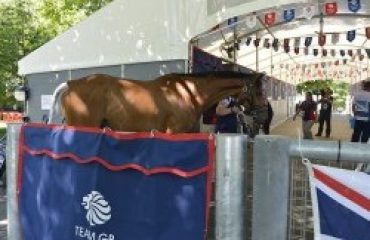
Charlotte Bredahl and Leo
Photo by Kate Burke
Charlotte Bredahl was a member of the 1992 bronze medal U.S. Olympic dressage team in Barcelona riding Monsieur. In 1997, she was part of the silver–winning team at the North American Championship on Lugano. She trained both horses from the start. Charlotte is a USEF (S) judge and FEI 4* judge who has judged all over the world. Three years ago, she was appointed USEF assistant youth coach and now dedicates most of her time to coaching. She recently purchased a home in Wellington, Florida, where she plans to spend winters. Do you have a question you want Charlotte to answer? Send questions to editor@sidelinesnews.com.
Be a Great Leader for Your Horse
Many years ago, I started taking ballroom dance lessons after watching the movie Saturday Night Fever. That made me a much more patient and empathetic rider and trainer. After taking lessons for a while, I found myself feeling quite confident when I was dancing with my instructor. He was a great leader and it was always easy for me to understand what I was supposed to do.
At times I would have a chance to dance with others who were not experienced dancers and I’d immediately lose my confidence and constantly second guess what they wanted me to do. That gave me a whole new understanding of what the horses go through on a regular basis. Very often we’re not clear enough with our aids and the horse tries to guess what we mean. A really good rider is a really good leader and the horse will easily understand what is asked of them.
Sometimes I see riders having trouble with a movement and assuming the horse is unwilling in his or her response. The majority of the time, it’s the rider not asking in a clear way or not sitting in the correct position. Very often alignment issues in the rider cause alignment issues in the horse. The rider always needs to be self-critical of themselves first and be sure they are asking the horse correctly before being critical of the horse.
For the most part, horses want to do what they think you want. If you repetitively blame them for something you did wrong, they’re going to start objecting and be unhappy in their work. I think the thing I am the proudest of, in all my years of training horses, is the fact that every horse I have owned over the past 20 years was happy in their work and people took notice of that. For the past few years, I’ve had to sell or place four of my own personal horses because of my busy schedule and lots of traveling. I still hear from their owners (each one handpicked for the horse) on a very regular basis. All of them will tell me how wonderful each horse is and how well-trained they are. I think the main reason is that I always treated them fairly and always listened to them. I always tried to set them up for success.
There are so many ways to set your horse up for success:
- Teach everything in small increments. Any time you teach something new, be happy with very little and then build on that.
- Celebrate and reward small successes and don’t get greedy too quickly. Never put a horse in a situation where you know or think he might fail.
- Give horses enough turnout time at home so they don’t have lots of excess energy. Turnout time is good for body and mind.
- Make sure the horse is physically fit and able to do what you ask. Build up slowly, so the horse doesn’t get sore in muscles or get injured.
- Make sure all the tack really fits the horse correctly. Have regular saddle fittings. Make sure the teeth are checked every six months and the bits fit well. If you seem to have mouth/connection issues, have a bit fitter come out.
- Have the horse checked over by your vet on a regular basis, to make sure there aren’t any soundness or health issues. Sometimes what seem like a training issue turns out to be a vet issue.
- Before you take a horse to his/her first show, go to a friend’s place and see how he handles a new situation. If there are problems, you can work through them without the stress of a show.
- Do everything possible to be well prepared before you go to a show. Make sure you have a good helper with you. Always show at a level where the horse and rider are very competent and confident. Don’t expect the horse to be better at a show than at home — it’s better to assume the opposite.
If you always try to set your horse up for success, you’ll avoid confrontations and the horse will never learn bad behavior. Horses learn bad behavior when they’re put in a bad situation and don’t know how to get out of it. Rearing is a learned behavior: When a horse has no other place to go, then they’ll go up. Make sure they always have a way to go forward instead.
Make sure you are physically fit enough to do what is required. For dressage riders, core strength is probably the most important part. Many riders have alignment issues that can be helped by working with physical therapists. We are very fortunate to have physio Andy Thomas working for the USEF and available for the riders in our programs.
I am extremely happy and proud to say U.S. Dressage really stands for beautiful and harmonious riding and we have some amazing combinations as role models.













